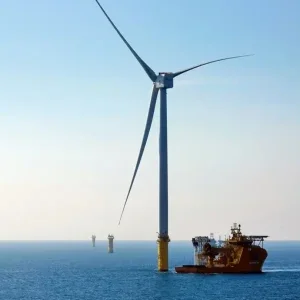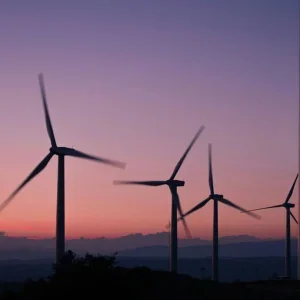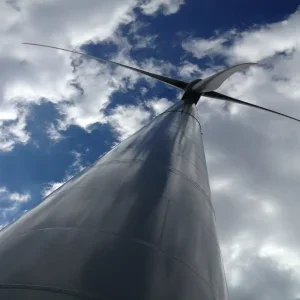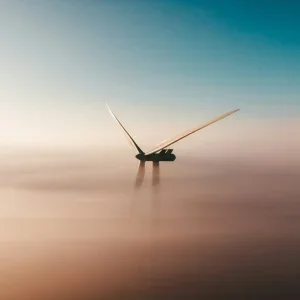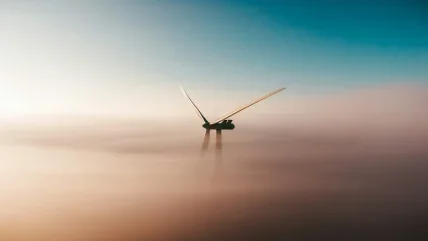
Wind turbines, insiders have long assured us, are a vital tool in the fight for a better tomorrow. Certainly, the statistics make it hard to disagree. According to the American Clean Power Association, for example, wind energy helps avoid 336 million tonnes of CO2 emissions each year – the equivalent of 76 million cars.
The electricity-producing potential of the sector is just as stark. Assuming an average turbine height of 90m, researchers at the University of Michigan speculate that onshore and offshore wind generation could produce a bewildering 872,000TWh of electricity annually. To put that into perspective, total global energy consumption is a mere 24,000TWh.
Once you factor in the economic benefits of the wind sector – and that it theoretically buffers countries from the vagaries of the global fossil fuels market – and you can see why EU nations are on course to bolster the bloc’s offshore wind capacity 25-fold by the end of the decade.
Yet, what comes up – it goes without saying – must also come down: and here policymakers and turbine manufacturers have shown distinctly less enthusiasm. Especially for offshore turbines – battered by waves and air, and challenging to maintain – there’s a distinct lack of clarity about what to do when their life cycle comes to an end, even as the typical wind farm can only function for about a quarter of a century.
Faced with the looming prospect of rows of crumbling turbines, legislators are belatedly starting to reflect on what can be done. In the first place, their problems are made much worse by a lack of research. Beyond some honourable exceptions, there is a concerning lack of knowledge over what removing turbines will do to the local marine environment – environments, remember, that were already altered when the turbines were first installed.
One solution, it appears, could involve renovating ageing turbines to give them a second lease of life. Another – though perhaps ironic for an industry built on sustainability – could be learning from how the oil and gas sector has approached decommissioning. There are even some suggestions that, for the good of the planet, old turbines are left as they are, providing shelter to underwater creatures even as their energy-producing days are done.
All for nothing?
It’s hard to overstate how quickly the problem of offshore decommissioning is going to increase. Consider the numbers. In principle, offshore machines should function properly for between 20–25 years, though worn-down components can sometimes hasten that estimate.
We must also factor in the wealth of turbine construction we’ve seen over recent decades – despite the challenging economic conditions, Europe still installed 4% more turbines in 2022 than the year before, equivalent to 19GW of new installed wind capacity, even as the Global Wind Energy Council estimates that climate goals require the construction of four times the current number each year.
With this in mind, it’s not hard to see why Dr Antony Knights says that turbine decommissioning is going to become “a pretty big problem” over the years ahead. That’s especially true, explains the associate professor in marine ecology at the University of Plymouth, in places like the North Sea. The UK may have been ahead of the game when it came to exploiting wind energy, but that equally means it’ll be among the first countries to deal with what comes next.
This looming crisis is hardly helped by the fact that the sector has struggled to plan ahead. In part, this is an issue of research. Beyond a couple of exceptions, notably in Northern Europe and the Gulf of Mexico, scientists have failed to fully consider what decommissioning would mean for the natural environment offshore turbines leave behind. At the same time, however, scientists and other stakeholders can build up a body of evidence based on another offshore industry, albeit one not traditionally associated with the green transition.
“Although decommissioning in the wind energy industry differs from that in the oil and gas and nuclear sectors, eventual decommissioning of offshore wind turbines will involve environmental considerations similar to those of other man-made structures,” explains Dr Michaela Schratzberger, science director at the Centre for Environment, Fisheries and Aquaculture Science (CEFAS), a government body that works with scientists and other stakeholders to build the evidence base in support of decommissioning decisions.
90%
The percentage of 40 industry experts surveyed in 2018 that said that governments should abandon the principle that offshore structures should always be removed.
University of Technology, Sydney, Australia
Yet, if they can offer plenty of pointers – including the need to design structures in a way that make them easy to dismantle, as well as the importance of securing the skills of decommissioning experts – oil and gas installations also pose challenges for turbines.
Fundamentally, this is a question of regulation, in particular a rule called OSPAR 98/3. Applying across the north-east Atlantic, involving 15 regional governments and encompassing both wind turbines and petroleum installations, it requires what the regulation describes as the ‘complete removal’ of most man-made structures from the sea.
“Although decommissioning in the wind energy industry differs from that in the oil and gas and nuclear sectors, eventual decommissioning of offshore wind turbines will involve environmental considerations similar to those of other man-made structures.”
Dr Michaela Schratzberger
Balancing acts
That might sound fine in theory. Why, after all, wouldn’t you want to return the marine environment to a pristine condition – especially in a sector predicated on sustainability like wind? In practice, however, such draconian rules may actually not be the best way forward.
Put it like this: the moment a turbine’s installed, the local environment is transformed already, and not necessary for the worse. Sea snails, algae and marine plants are all drawn to the turbines, notes Knights, explaining that some turbines mimic the ecosystems of rocky shores. From there, he continues, seabirds can find a home among offshore structures, as can certain species of fish.
This point is supported by the numbers: researchers in Germany have found that a typical offshore turbine can support up to four tonnes of shellfish, a bounty that’s sure to attract crabs and fish, themselves the natural prey of seals.
And while there are certainly downsides to transforming the sea in this way – the fact that invasive species can also be drawn to human-made sites, Knights concedes, means they’re always “a double-edged sword” – is it really worth disrupting nature two times over?
Whatever you believe, the persistence of OSPAR 98/3 means that any attempt at thoughtful discussion is immediately quashed. At least, this is true where that particular rule is enforced. For while northern Europeans are obliged to decommission turbines from generator to blade, their US cousins are far less constrained.
More to the point, Schratzberger explains that experience shows that a more holistic approach to turbine afterlife can be successful. As she puts it: “In some parts of the world, particularly in the US, alternative strategies such as allowing relocation of infrastructural components – generally jackets – to create artificial reefs, or repurposing them in other ways, have been allowed often with considerable success.”
19GW
New installed wind capacity in Europe in 2022.
WindEurope
Off the coast of California, for instance, the decommissioned Platform Holly oil rig plays host to fish, crabs and starfish. Other exhausted platforms in the Gulf of Mexico, have become popular diving and fishing spots. Once again borrowing from the petroleum sector, meanwhile, there’s little reason wind turbines couldn’t enjoy a similar legacy.
Not that gentle neglect is the only option here either. With timber an increasingly popular construction material for new turbines – specialist laminated wood manufacturer Modvion partners with industry giants like Vestas – we could theoretically see turbines disintegrate almost entirely by natural means.
336
million The amount in metric tons of CO2 emissions avoided by wind energy each year – the equivalent of 76 million cars.
American Clean Power Association
At the other end of the spectrum, Knights is an enthusiastic supporter of renovating older turbines, giving them a second lease of life, and neatly putting off decommissioning worries a while longer. There are signs, in fact, that this is happening already. As far back as 2018, for instance, a Danish company successfully replaced five turbines near the Swedish coastline, doubling the site’s energy output even as the old towers and foundations were preserved.
On a mission
There’s no single answer to offshore decommissioning, and where you come down is almost a matter of philosophy. Pointing out that the planet is losing biodiversity at an unprecedented rate, largely thanks to climate change, Knights argues that “we’re going to trade off” the health of the planet as a whole with that of those of specific ecosystems.
By the time you factor in the varying costs and benefits of decommissioning turbines themselves, you end up with a field that’s deeply complex – and one with the potential to upset someone or other. As Schratzberger says: “A decommissioning strategy that benefits some stakeholders may be detrimental to others, for instance, a strategy that benefits fishermen may undermine some conservation objectives.”
Yet, if just exactly how turbines end their days seems destined to remain disputed, industry insiders are at least becoming more conscious of the problem. In 2021, the Offshore Renewable Energy (ORE) Catapult, a British industry group, announced a five-year programme that brought together academics, manufacturers and policymakers to reflect on how decommissioning could be streamlined. That’s shadowed by a flurry of other research, not least by Knights and his colleagues, which altogether is contributing to a sector due to enjoy CAGR of 13.46% through 2026.
Even the infamous OSPAR 98/3 ruling could eventually disappear, with a paper from 2018 by the University of Technology in Sydney, Australia, finding that over 90% of the industry experts surveyed advocate a case-by-case approach to offshore structure removal – rather than the blanket policy currently in force. All the while, thousands of turbines continue to age, even as what happens to them remains decidedly unclear.


